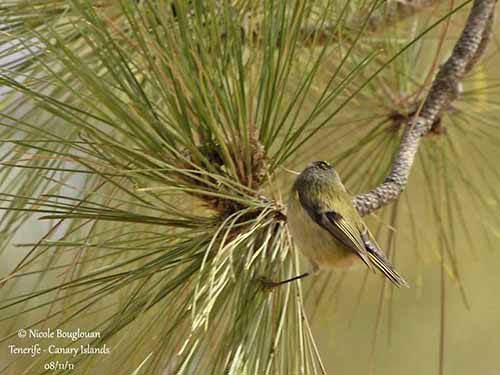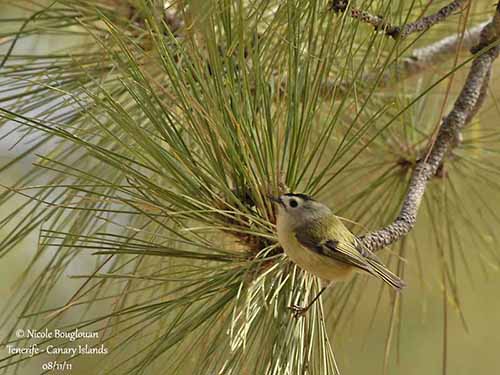
Fr : Roitelet de Tenerife
All: Sommer-Goldhähnchen
Esp: Reyezuelo Canario, Reyezuelo Tinerfeño
Ita: Regolo delle Canarie
Nd: Tenerifegoudhaan
Sd: Kanariekungsfågel
Photographer:
Nicole Bouglouan
PHOTOGRAPHIC RAMBLE
Text by Nicole Bouglouan
Sources:
HANDBOOK OF THE BIRDS OF THE WORLD Vol 11 by Josep del Hoyo, Andrew Elliott and David Christie - Lynx Edicions - ISBN: 849655306X
Wikipedia, la enciclopedia libre
Avibird.com – Bird Guide Online
The Encyclopedia of Hearth - Canary Islands dry woodlands and forests
Canary Islands Kinglet
Regulus teneriffae
Passeriformes Order – Regulidae Family
INTRODUCTION:
The Canary Islands Kinglet is first, a subspecies of the Goldcrest (Regulus regulus). However, it is now often considered a full species.
In the Canary Islands, two subspecies are living in separate ranges, but both frequent the pine forest with native endemic Pinus canariensis and introduced Pinus radiata.
DESCRIPTION OF THE BIRD:
Biometrics:
Length: 8-9 cm
Weight: 5-7 g
The adult is a compact, tiny bird. The male has pale olive-green upperparts, white wingbar and black patch on secondary’s bases. Flight feathers and rectrices show narrow yellowish edges.
On the underparts, chin and throat are pale yellowish-white in fresh plumage. Rest of underparts such as breast, belly and undertail-coverts are pale yellowish-olive but darker than in Goldcrest.
On the head, we can see two black lateral crown stripes meeting on forehead, and contrasting with bright orange crest on top of crown. There is a whitish area around the eyes, and a narrow, black malar stripe.
The Canary Islands Kinglet is slightly smaller than the Goldcrest, with longer black bill. The eyes are dark brown. Legs and feet are dark brown to blackish.
The female is similar but she has yellow crest instead of orange.
The juvenile is duller and lacks the bright head pattern of the adults.

SUBSPECIES AND RANGE:
R.r. teneriffae (here described and displayed) is found in WC Canary Islands, on La Gomera and Tenerife Islands.
R.r. ellenthalerae occurs in W Canary Islands, on La Palma and Hierro Islands.
This one has finer bill. The underparts are less brownish. The central crown patch is paler in male and it has duller plumage overall.
It has been described as separate race in 2006.
HABITAT:
The Canary Islands Kinglet frequents the pine forest, but it can also be found in heathlands and occasionally in dry pine woodlands and nearby cultivated areas. It may frequent too the laurel thickets, at least the remnant patches.
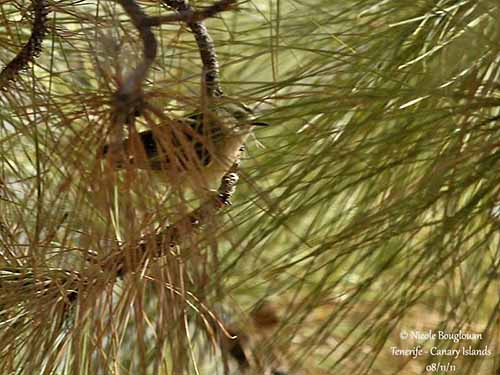
CALLS AND SONGS: SOUNDS BY XENO-CANTO
The Canary Islands Kinglet R.r. teneriffae utters high-pitched, rapid trill “tee-de-dee tee-de-dee” ending in lower-pitched flourish.
XENO-CANTO - R.r. teneriffae
The Canary Islands Kinglet R.r. ellenthalerae has shorter song.
XENO-CANTO - R.r. ellenthalerae
The calls “seech” or “zick” are quiet and high-pitched, but sometimes louder.
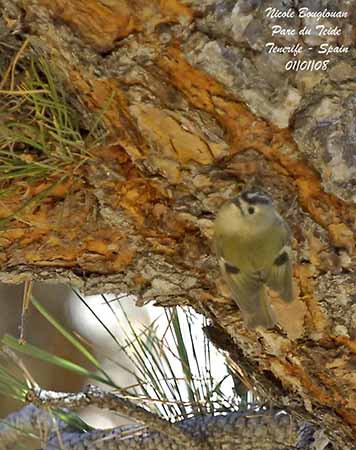
BEHAVIOUR IN THE WILD:
The Canary Islands Kinglet feeds on small arthropods and spiders, caught in trees while foraging along branches among the foliage. It often clings and hangs from twigs.
During winter, it mostly feeds on seeds and small berries, and catches long-legged insects on the ground such as orthoptera.
It may sometimes hover to catch preys in flight or from spider webs.
The Canary Islands Kinglet breeds when there are abundant food resources. During the breeding season, the bright-coloured orange or yellow crest is displayed. During encounters, the crest is raised while the male adopts an upright posture with stretched neck and fanned tail.
In the Canary Islands, they usually nest in tree-heath Erica arborea, and occasionally in laurel Laurus azorica, in Canary pine or Monterey Pine.
The Canary Islands Kinglet is resident and endemic to the Canary Islands.
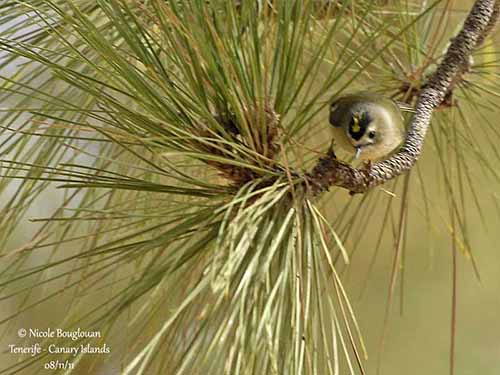
REPRODUCTION OF THIS SPECIES:
The breeding season occurs when they can find abundant food sources.
Male and female build the nest, a cup-shaped structure oriented between horizontal branches of tree-heath, like a hammock, or on outer branches in conifer, at about 15 metres above the ground. The building may last up to three weeks.
The nest includes three layers of different materials. The outer part is made with mosses and lichens, fixed with spider webs and attached to the branches. The middle layer contains flimsy mosses and a few lichens. The inner part is lined with soft materials such as animal hair and feathers.
This structure is almost spherical with an entrance close to the top.
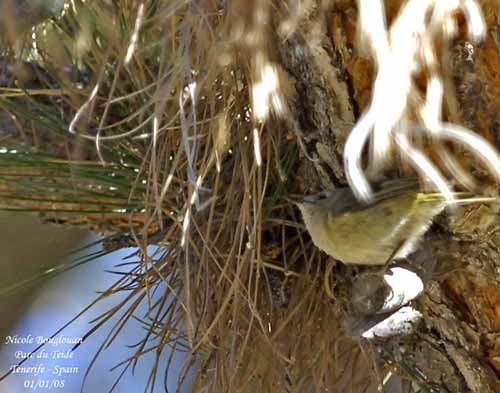
The female lays 9-12 pale eggs with a few markings. She incubates during 16 days. She broods and cares the young during the first week. Later, both parents feed the chicks. They fledge about 17-22 days after hatching.
The adults often prepare the next brood while still feeding the first one. This species produces two broods per season, giving about 20 young per year.
PROTECTION / THREATS / STATUS:
Both races of the Canary Islands Kinglet are threatened by habitat loss such as the laurel forest. Increase of human developments for tourism and introduced predators may also threaten this species.
However, the populations appear to be stable, and the Canary Islands Kinglet is not currently threatened and evaluated as Least Concern.
